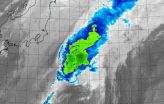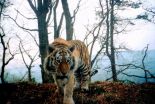(Press-News.org) The distribution of birds in the United States today will probably look very different in 60 years as a result of climate, land use and land cover changes.
A new U.S. Geological Survey study predicts where 50 bird species will breed, feed and live in the conterminous U.S. by 2075. While some types of birds, like the Baird's sparrow, will likely lose a significant amount of their current U.S. range, other ranges could nearly double. Human activity will drive many of these shifts. The study was published today in the journal PLOS ONE.
"Habitat loss is a strong predictor of bird extinction at local and regional scales," said Terry Sohl, a USGS scientist and the author of the report. "Shifts in species' ranges over the next several decades will be more dramatic for some bird species than others."
Climate change will cause average temperatures to change by three degrees to seven degrees Fahrenheit by 2075, depending upon scenario and location within the conterminous U.S. Temperature increases will drive breeding ranges for many species to the north. Precipitation will increase in some regions and decline in others, resulting in substantial impacts on local and regional habitat.
Habitats for birds currently breeding in the far southern U.S., such as the desert-dwelling Gambel's quail and cactus wren, will expand greatly by 2075 in the conterminous U.S. as a warming climate moves the overall range to the north. The chestnut-collared longspur, sharp-tailed grouse and gray partridge could all lose over 25 percent of their suitable breeding range in the northern U.S. as climate becomes more suitable in Canada for these species. The Baird's sparrow may lose almost all of its current U.S. range.
Landscape changes resulting largely from human activity, including land use and land cover changes, will also significantly affect future U.S. bird distributions. The effects of landscape change will be more scattered, with very high loss of habitat at local and regional scales.
"Changing landscape patterns such as deforestation and urban growth are likely to have at least as large of an impact on future bird ranges as climate change for many species," Sohl said.
The new study used climate and landscape data to create and compare U.S. distribution maps of 50 bird species in 2001 and 2075. The maps for each species are available online.
The species that will either gain or lose more than 20 percent of their conterminous U.S. ranges as compared to 2001 are:
Gambel's quail: 61.8 percent gain
Cactus wren: 54.1 percent gain
Scissor-tailed flycatcher: 46.4 percent gain
Gray vireo: 44.9 percent gain
Painted bunting: 38.5 percent gain
Anna's hummingbird: 27.2 percent gain
Black-capped chickadee: 21 percent loss
Ferruginous hawk: 21.2 percent loss
Sora: 22.8 percent loss
Northern harrier: 24.7 percent loss
Bobolink: 24.9 percent loss
Short-eared owl: 26.2 percent loss
Vesper sparrow: 26.4 percent loss
Savannah sparrow: 27.2 percent loss
Sedge wren: 29 percent loss
Gray partridge: 35.6 percent loss
Sharp-tailed grouse: 44.8 percent loss
Chestnut-collared longspur: 54.1 percent loss
Baird's sparrow: 90.8 percent loss
INFORMATION:
For more information on species distribution modeling, please visit the USGS Earth Resources Observation and Science Center website.
USGS provides science for a changing world. Visit USGS.gov, and follow us on Twitter @USGS and our other social media channels.
Subscribe to our news releases via e-mail, RSS or Twitter.
Links and contacts within this release are valid at the time of publication.
NASA's Terra satellite passed over Tropical Storm Nuri on Nov. at captured an infrared picture of the storm. The storm looked more like a frontal system as it stretched from northeast to southwest.
The Moderate Resolution Imaging Spectroradiometer or MODIS instrument that flies aboard NASA's Terra satellite flew over Nuri on Nov. 6 at 1240 UTC (7:40 a.m. EST). The MODIS image showed some strong thunderstorms remaining in a small area around Nuri's center, but the storm appeared stretched out from northeast to southwest. Wind shear was affecting the storm, stretching it ...
(SALT LAKE CITY)--One of the big hurdles in bringing drugs to market is the difficulty of producing large enough quantities of potential compounds to conduct clinical trials. This is particularly true with compounds made by organisms, which usually are produced in exceedingly small amounts and are difficult to synthesize in the laboratory.
Researchers from the University of Utah College of Pharmacy have made an important stride in addressing those problems. In a study in ACS Synthetic Biology, researchers led by Eric W. Schmidt, Ph.D., professor of medicinal chemistry, ...
The fifth tropical cyclone of the Northern Indian Ocean season formed in the Bay of Bengal as NASA's Terra satellite passed overhead and captured an image of the storm.
When Terra passed over Tropical Cyclone 5B on Nov. 6 at 05:05 UTC (12:05 a.m. EST), the MODIS instrument aboard took a visible image of the storm. The MODIS image showed a concentrated storm with strong thunderstorms circling tight around the center and in the northeastern quadrant.
By 1500 UTC (10 a.m. EST), Tropical Cyclone 5B was located near 13.4 north latitude and 87.9 east longitude. That's about ...
NEW YORK (November 6, 2014) -- Inappropriate, disruptive, or hostile behavior between nursing home residents is a sizable and growing problem, according to new research from Weill Cornell Medical College and Cornell University.
The study found that nearly one in five nursing home residents were involved in at least one negative and aggressive encounter with one or more fellow residents over the previous four weeks. These included acts of verbal or physical abuse, inappropriate sexual behavior, or invasion of privacy, among other incidents, known collectively as resident-to-resident ...
DURHAM, N.C. -- There may be a scientific answer for why conservatives and liberals disagree so vehemently over the existence of issues like climate change and specific types of crime.
A new study from Duke University finds that people will evaluate scientific evidence based on whether they view its policy implications as politically desirable. If they don't, then they tend to deny the problem even exists.
"Logically, the proposed solution to a problem, such as an increase in government regulation or an extension of the free market, should not influence one's belief ...
Eight percent of your genome derives from retroviruses that inserted themselves into human sex cells millions of years ago. Right now the koala retrovirus (KoRV) is invading koala genomes, a process that can help us understand our own viral lineage and make decisions about managing this vulnerable species.
In a recent study scientists from the University of Illinois discovered that 39 different KoRVs in a koala's genome were all endogenous, which means passed down to the koala from one parent or the other; one of the KoRVs was found in both parents.
Koalas are the ...
It's a difficult career transition that can lead to more professional frustration and shorter tenure on the job for many of the newest generation of veterans employed with the U.S. Department of Veterans Affairs (VA) compared to their non-veteran co-workers.
New research from the University of Cincinnati is helping VA analyze the process of reintegrating veterans into civilian careers and evaluate methods for easing that transition. That's good news for all veterans as the nation prepares to observe Veterans Day on Nov. 11.
"This period of time within our labor force ...
The "food" sources that support Florida red tides are more diverse and complex than previously realized, according to five years' worth of research on red tide and nutrients published recently as an entire special edition of the scientific journal Harmful Algae.
The multi-partner project was funded by the National Oceanic and Atmospheric Administration's ECOHAB program* (described below) and included 14 research papers from seven institutions.
The research team studied four red tide blooms caused by the harmful algae species Karenia brevis in 2001, '07, '08 and '09, ...
Our genetic makeup influences whether we are fat or thin by shaping which types of microbes thrive in our body, according to a Cornell-led study published today in the journal Cell.
By studying pairs of twins, researchers identified the Christensenellaceae bacterial family, which is highly heritable and more common in lean individuals. Moreover, a member of this class of bacteria, Christensenellaceae minuta, protected against weight gain when transplanted into mice.
The findings pave the way for personalized probiotic therapies that are optimized to reduce the risk ...
Along with the pressures of habitat loss, poaching and depletion of prey species, a new threat to tiger populations in the wild has surfaced in the form of disease, specifically, canine distemper virus (CDV). According to a new study from the Wildlife Conservation Society (WCS) and its partners, CDV has the potential to be a significant driver in pushing the animals toward extinction.
While CDV has recently been shown to lead to the deaths of individual tigers, its long-term impacts on tiger populations had never before been studied.
The authors evaluated these impacts ...





